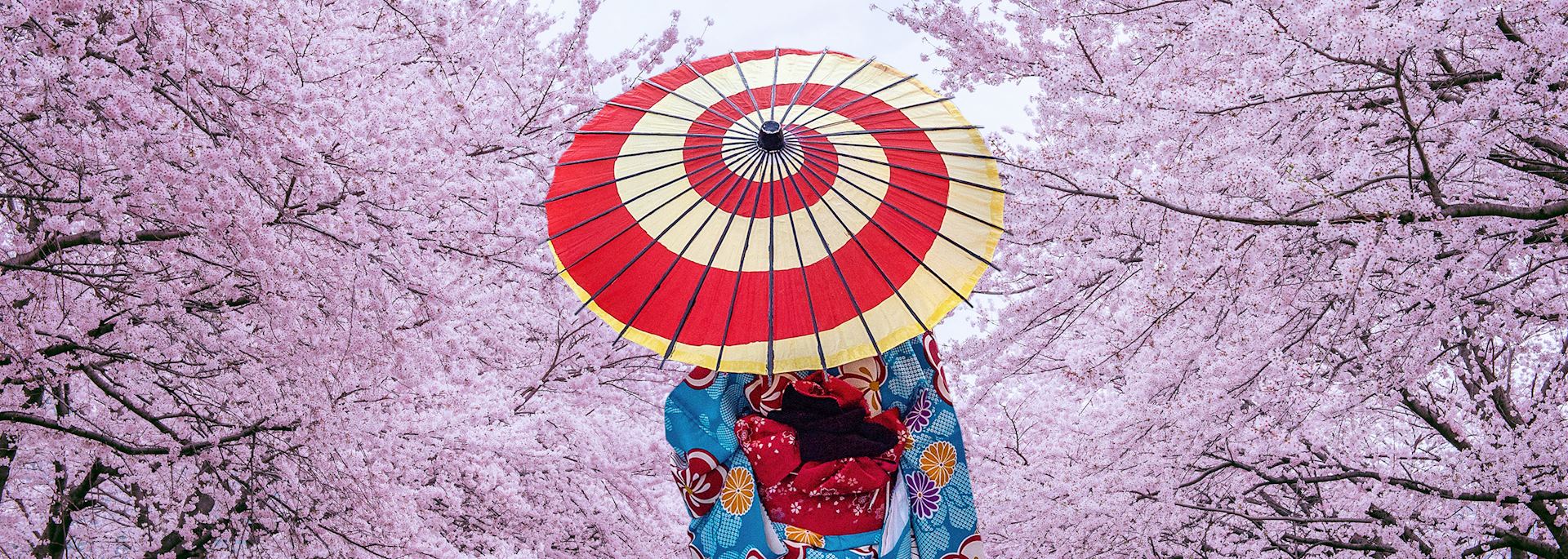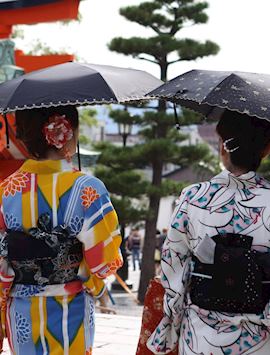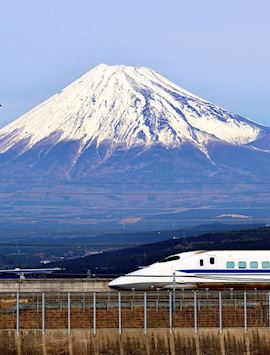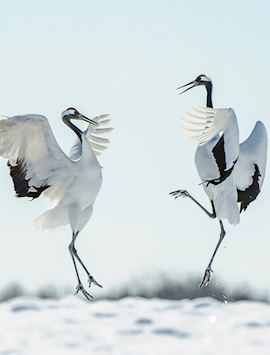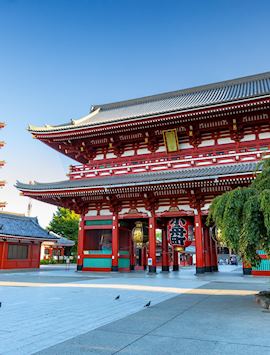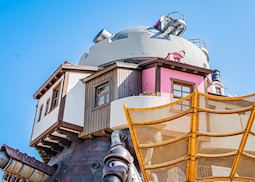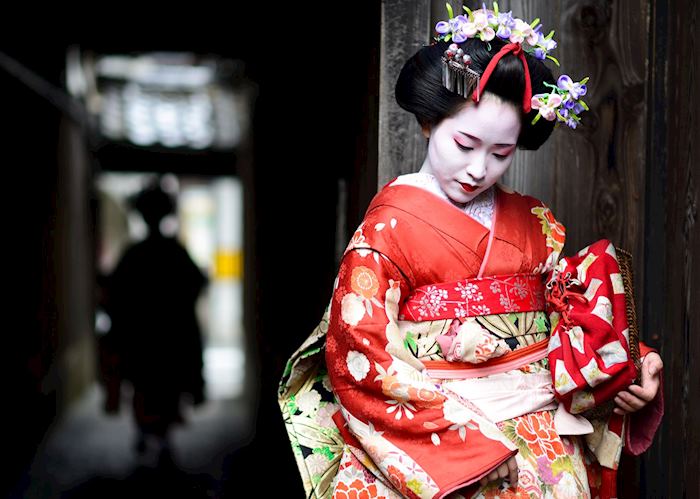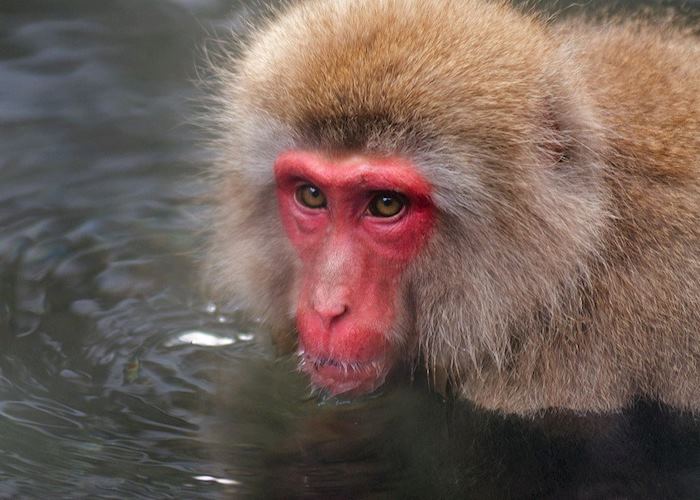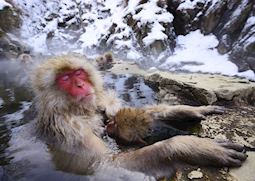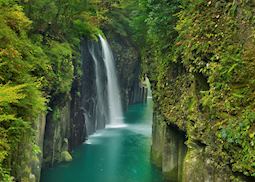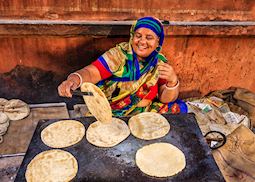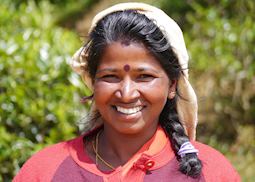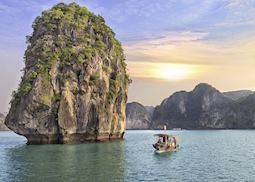
Japan’s distinct culture, futuristic cities and striking natural landscapes make it one of our most rewarding destinations. While the lifestyle may seem intimidatingly different, our specialists have spent time living, and often working, in the country and can help you navigate the cultural idiosyncrasies. With their expert guidance and help in planning your tailor-made itinerary, experiencing a culture far removed from your own is part of the country’s charm.
In one bullet train journey, you can travel from the neon-lit streets of Tokyo to the fresh, clean air of the Japanese Alps. Buddhist temples dot the country, and you can stay in traditional ryokan inns for a taste of Japanese life from a bygone era. Our specialists can advise on everything from the best local festivals to attend, to which local delicacies to try during your vacation to Japan.
They can also arrange for you to see Japan from a different vantage as you cruise the archipelago. During your time in port, you can wander amid the towering blue-green stalks of Kyoto’s Arashiyama Bamboo Forest, see the “floating” red torii gate near Hiroshima, and, in Kanazawa, take part in a gold leaf workshop to celebrate the city’s signature craft.
Suggested tours for Japan
Whether you want to visit the snow monkeys at Yudanaka Onsen, take in the vibrant culture in Kyoto, or relax on one of Okinawa’s pristine white beaches, our range of suggested itineraries are a great starting point as you begin to plan your trip to Japan.
Suggested activities for Japan
Enjoy a guided walk around the Geisha district of Gion, hike in the Northern Alps or take the family to Tokyo Disneyland. Whatever captures your interest, our specialists will suggest experiences designed to enhance your trip to Japan.
-
Visit Tokyo Disneyland ![DisneySea]()
Visit Tokyo Disneyland
TokyoVisit Tokyo Disneyland
Enjoy the rides and atmosphere at Tokyo's Disneyland and DisneySea.
View details -
Tokyo city tour ![Shibuya Scramble Crossing, Tokyo]()
Tokyo city tour
TokyoTokyo city tour
Begin your day with a visit to Meiji Jingu shrine in Harajuku, one of Tokyo's busiest sights but an oasis of calm in the early morning. From here wander through the shopping streets of Harajuku and head south to Shibuya for morning coffee and people watching at the Hachiko pedestrian crossing.
View details -
Visit the Ghibli Anime Museum ![Ghibli Museum, Mitaka, Tokyo]()
Visit the Ghibli Anime Museum
TokyoVisit the Ghibli Anime Museum
Mitaka is a pleasant suburb of Tokyo. The town is home to the Ghibli Museum, an interactive exhibition containing all things related to the animated world created by Studio Ghibli, Japan's premiere animation studio.
View details
Why travel with Audley?
- 100% tailor-made tours
- Fully protected travel
- Established for over 25 years
- 98% of our clients would recommend us
Best time to visit
Our specialists advise on the best months to visit Japan, including information about climate, events and festivals.
Request our brochure
Covering all seven continents, The World Your Way shows you how you can see the world with us. It features trip ideas from our specialists alongside hand-picked stays and experiences, and introduces our approach to creating meaningful travel experiences.
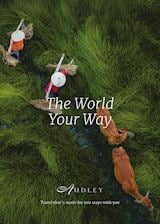
Useful information for planning your vacation in Japan
Japanese is the official language of Japan, though some English is spoken in major cities. Many signs are in English, particularly on public transportation and roadways, making it easy to navigate.
The currency in Japan is the yen.
There’s no culture of tipping in Japan, and nobody expects it. Compulsory service charges are levied in some hotels and restaurants.
For the latest travel advice for Japan, including entry requirements, health information, and the safety and security situation, please refer to the State Department website.
Many visitors come to Japan to immerse themselves in the country’s singular culture — both traditional and ultra-modern. You can explore the lantern-lit alleys on a guided tour of Gion, Kyoto’s renowned geisha district, or dive into the cutting-edge tech and pop-culture scene with a guided tour of Tokyo’s different districts.
For more hands-on approach, you might consider a class. You can learn to make ramen, try your hand at taiko drumming, or take a kintsugi workshop to learn the art of mending broken pottery with gold.
While the cultural aspects of Japan are often visitors’ primary focus, there are plenty of opportunities to explore the country’s natural beauty. You can walk through majestic cedar forests on the Nakasendo Highway, climb the three sacred mountains of Dewa-Sanzan, or venture further afield to find pristine swathes of nature in Hokkaido.
Spanning the gamut from luxurious ultra-modern hotels to charmingly rustic ryokan, Japan offers a wide range of stays in both the cities and the countryside. Where you stay depends on what you want to see and your personal style — your specialist will help you choose the right option for you.
For the most authentic experience of Japan, we do recommend spending at least one night in a ryokan. These inns range from rustic B&Bs perched amid the mountains to Kyoto’s most sublimely sophisticated establishments.
You can also opt to immerse yourself in the country’s spiritual side with a stay in shukubo — lodgings within a Buddhist temple, like those found on Mount Koya. These spartan quarters give you a front-row seat to the daily life in the hushed, holy spaces.
If you’re only going to visit Japan once, you should make time to see both Tokyo and Kyoto. A visit to these two cities, which are connected by a bullet train, gives you the chance to explore both the modern and traditional sides of the country.
If you want to extend your stay, where you go depends on what you’re interested in and what time of the year you visit. You might want to unwind like the locals do and stay in a ryokan (rustic inn), soaking in a natural hot spring onsen. In spring, the country’s many cherry trees explode into pink bloom, attracting visitors from around the world. To explore the wilder side of the archipelago, you might head north to the Japanese Alps to hike the Nakesendo Highway.
Japan’s excellent train network makes it easy to move between cities, even small ones. Within the cities, you can take advantage of an efficient and comprehensive subway and bus system. We can help you navigate this system with how-to guides, detailed instructions, and even a guide who will meet you early in your trip to give you an orientation tour and explain the nuances.
Driving yourself is an option, but not recommended if you want to spend most of your time in the cities, where traffic is dense. Your rental car will come with GPS, and all road signs are in Japanese and English, so navigating is usually easy. You’ll need both a valid US driving license and an International Driving Permit.
Nonstop flights from New York City to Tokyo take about 14 hours, depending on airline.
The time zone in Japan is UTC +9.
Use our travel tool to find up-to-date visa and passport requirements for Japan. Enter where you’re traveling to and from (including any stopover destinations en route or flight layovers), along with your intended travel dates and passport details, for a full list of requirements.
Your doctor can provide you with immunization advice for Japan, but you should also ensure you’re up to date with the recommended vaccinations for your home country. You can also check the recommended vaccinations by visiting the Centers for Disease Control and Prevention website.
Some of Japan’s best cuisine to try includes ramen, sushi, sashimi, bento boxes, teriyaki, sukiyaki, tempura, and nabe. Additionally, you can sample a wide range of sake and beer brands. With one of the world’s most sophisticated and distinctive cuisines, Japan offers a veritable feast of options for any visitor — and any guide to eating in Japan is necessarily merely an introduction.
It’s easy to enjoy yourself at any price range, from inexpensive noodle bowls to opulent Michelin-starred eateries. A highlight for many is a kaiseki meal at a ryokan. Serenely formal, these multi-course meals celebrate the seasons, featuring only very local ingredients. On the other end of the spectrum, izakaya offer a boisterous, social experience with inexpensive tapas-style menus of small, often-fried dishes.
A guided tour can also help you get your bearings, whether you’re sampling street food in Tokyo, traditional cuisine in Kyoto, or soul food in Osaka.
The title of best sushi restaurant is fiercely fought over, but for the best city, we suggest Kanazawa. Kanazawa is best known for its rich tradition of crafts, but its location also gives it access to some of the country’s freshest fish, caught in the icy waters of the Sea of Japan. (The cold water is thought to improve the taste.) You can also take a tour of Ōmichō Market, an old-fashioned fish market where you can watch the fishmongers ply their trade and pick up some sashimi.
This is, of course, a matter of taste but many agree that the tonkatsu ramen in Fukuoka City is the best in the country. Fukuoka is considered the Noodle Capital of Japan thanks to its no-frills tonkatsu ramen with ultra-fine noodles. You can find it dished out every day in big bowls at more than 100 stalls across the city. It’s easy to include the city as part of our self-drive tour of Kyushu.
Where to find best okonomiyaki is a contentious question — both Osaka and Hiroshima claim that accolade. The word literally translates as ‘whatever you want, grilled’, which is an accurate description — these popular street snacks are savory pancakes loaded with whatever protein and accouterments you’d like. Both Hiroshima and Osaka are located on the main island, making them easy to visit on a classic tour of Japan.
Each region is justifiably proud of their local sake, but the Kansai region — including Kyoto, Osaka, Hyogo, and Nara prefectures — has perhaps the densest concentration of excellent sake in the country. The drink, which is called nihonshu in Japan, has been brewed in this region for centuries. To get a glimpse of the process, we can arrange a culinary walking tour of Kyoto that includes a visit to a sake brewery and the Gekkeikan Okura Sake Museum.
Japan in pictures
Our expert guides to traveling in Japan
Written by our specialists from the viewpoint of their own travels, these guides will help you decide on the shape of your own trip to Japan. Aiming to inspire and inform, we share our recommendations for how to appreciate Japan at its best.
-
![Japan: the Audley way]()
Japan: the Audley way
Get to know Japan’s true character on a trip crafted for you by Audley’s specialists. You could explore Tokyo’s restaurants with a food expert, don a kimono for a green tea ceremony, or glimpse a geisha on the streets of Kyoto.
-
Family holidays to Japan ![Snow monkeys of Yudanaka]()
Family holidays to Japan
Family holidays to Japan
A futuristic and vibrant country, Japan is a destination that appeals to family members of all ages. Safe, clean and with a good infrastructure, there are plenty of ways to explore. Japan specialist, Jake, talks us through how to get the most of your family vacation in Japan.
Read this guide -
Japan’s seasons: cherry blossom and beyond ![Cherry blossom in Kyoto]()
Japan’s seasons: cherry blossom and beyond
Japan’s seasons: cherry blossom and beyond
Each Japanese season brings a raft of distinct experiences, from spring’s cherry blossom to winter’s snow crab delicacies. Japan specialist Laura shares the highlights of each time of year to help you decide when to visit Japan.
Read this guide -
11 best places to visit in Japan ![Geisha of Japan]()
11 best places to visit in Japan
11 best places to visit in Japan
To help you decide where to go in Japan, we’ve put together a list of our top places to visit. You might stay in a Buddhist temple on Mount Koya, learn how to make udon noodles in Shikoku, or attend an authentic tea ceremony in Kanazawa.
Read this guide -
Top 9 trips to Japan ![Takachiho Gorge, Kyushu]()
Top 9 trips to Japan
Top 9 trips to Japan
An authentic tea ceremony in Kyoto, Tokyo’s neon-lit streets, the volcanic landscapes of Kyushu… where will your trip to Japan take you? We’ve curated our specialists’ top tour ideas to inspire your travels.
Read this guide
Other popular destinations
Still looking for ideas? If Japan has captured your interest, we think you might also like these destinations.
